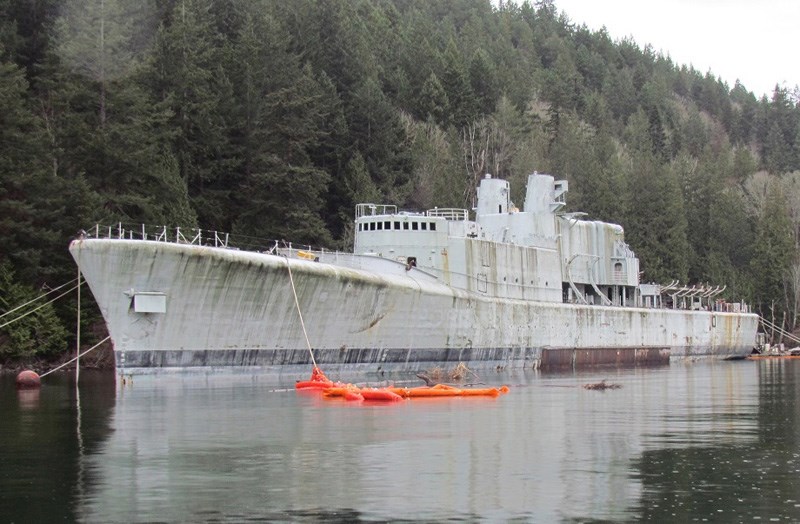The Artificial Reef Society of B.C. (ARSBC) has the OK from the province and a permit from Environment Canada to sink the HMCS Annapolis in Halkett Bay in 2015, but one more inspection is needed, and what has been described as “toxic paint” may call for more clean up.
The ARSBC has been trying to sink the Annapolis (a 115-metre decommissioned warship) in Halkett Bay to create an artificial reef since 2009.
The project has faced much opposition from the group Save Halkett Bay, which is comprised of property owners in the area. They have alleged the sinking will harm the ocean floor and sea life in the area. In the past, the group found polychlorinated biphenyls (PCBs) onboard the Annapolis that required further clean up.
Now the group says they have found tributyltin chloride or TBT in paint on the bottom of the vessel.
Used as an anti-fouling agent, TBT works by poisoning organisms like barnacles and algae. It leaches into the water and can accumulate on the sea floor and continue to release toxins for up to 30 years. It can also accumulate in fish and other sea life, which can lead to several different growth abnormalities.
The substance has been banned in Canadian waterways since 2008 for its harmful effects.
“The tributyltin-laced paint is contrary to international, federal and provincial laws and is the most toxic substance ever voluntarily introduced into the marine environment,” said Save Halkett Bay spokesperson Gary MacDonald. “No amount of this substance is permitted on a ship. Before sinking the ship, the ARSBC will have to remove this paint.”
Whether Environment Canada will require the ARSBC to remove the paint is yet to be seen, but Save Halkett Bay is pushing for it through a notice of objection and request for a board review, filed with Environment Canada on Dec. 9.
“What has to happen in order for this ship to be clean is you have to get it into dry dock and you have to sandblast off the paint and then you’re good to go. But if you don’t do that, then you’ve got this toxin, which is being released into the environment,” said barrister for Save Halkett Bay Martin Peters. “It doesn’t really matter if the ship is sitting at the bottom of Halkett Bay or sitting in the harbour where it is now, while we talk it’s still leaching this deadly poison into the waters around Gambier Island, so you know it’s not just a sinking problem, it’s a big problem.”
ARSBC president Howard Robins said his group has been meeting all of the Environment Canada requirements, as evidenced by their permit to sink the Annapolis, issued in October, and he called the TBT issue “a red herring.”
“They’re talking about the anti-fouling line paint on the ship, so the tributyltin material. What they don’t seem to realize is that the anti-fouling line paint is designed for the marine environment. So if they’re going to talk about anti-fouling line paint, then they’re talking about any craft that has anti-fouling line paint in the ocean,” Robins said.
“It’s a red herring. It’s just whatever argument they can create just to prevent the project from sinking. That’s really what it comes down to. If the government required the anti-fouling line paint to be removed, they would have put it in the standards. It’s not in the standards.”
Environment Canada is currently reviewing the issue; however, a spokesperson would not comment on whether it would stall the sinking, which Robins said “is imminent.”
Preparations are well underway to sink the ship with explosives and the Environment Canada permit allows for its disposal at sea in January.
“We have no requirement for the project to stop by the government and so as far as we’re concerned it’s full steam ahead,” Robins said.
A final inspection by Environment Canada is needed, however, before the Annapolis can officially go down.
“We’re currently working on setting that up,” Robins noted.
A former lawsuit against the ARSBC by Wesley Roots of WR Marine Services, which had the vessel seized by the courts, was settled in late 2014 according to Robins.
“We put in a request to have the arrest lifted and the courts agreed with that and they lost,” he said.
The disposal at sea permit issued by Environment Canada to the ARSBC is valid until Oct. 13, 2015 however it notes that the ARSBC “must not conduct the transport and disposal” between Feb. 1 and Aug. 14, 2015.



